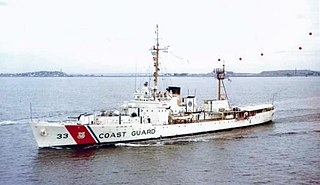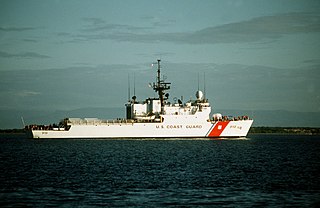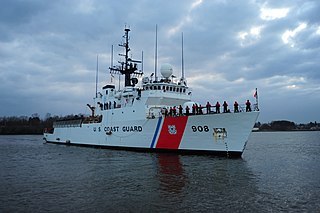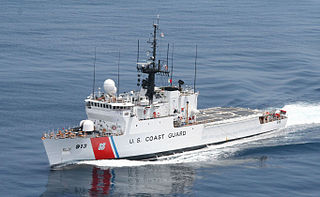
USCGC Tamaroa (WAT/WMEC-166), originally the United States Navy Cherokee-class fleet tugUSS Zuni (ATF-95), was a United States Coast Guard cutter. Following the U.S. Coast Guard custom of naming cutters in this class of ship after Native American tribes, she was named after the Tamaroa tribe of the Illiniwek tribal group.

USCGC Acushnet (WMEC-167) was a cutter of the United States Coast Guard, homeported in Ketchikan, Alaska. She was originally USS Shackle (ARS-9), a Diver-class rescue and salvage ship commissioned by the United States Navy for service in World War II. She was responsible for coming to the aid of stricken vessels and received three battle stars during World War II, before a long career with the Coast Guard. Acushnet patrolled the waters of the North Pacific and was one of the last World War II era ships on active duty in the US fleet upon her retirement in 2011.

SLNS Vijayabahu (P627) is an Advanced Offshore Patrol Vessel of the Sri Lanka Navy. The ship is named after King Vijayabahu I, the warrior king of the medieval Sri Lanka who founded the Kingdom of Polonnaruwa.

The USCGC Bibb (WPG-31) was a 327-foot (100 m) Secretary-Class Coast Guard ship commissioned in 1936. Seven similar "combat cutters" were built and named for secretaries of the United States Treasury. Bibb was named for U.S. Secretary of the Treasury George M. Bibb.

The Treasury-class cutter was a group of seven high endurance cutters launched by the United States Coast Guard between 1936 and 1937. The class were called the "Treasury class" because they were each named for former Secretaries of the Treasury. These ships were also collectively known as the "327's" as they were all 327 feet (100 m) in length. The Treasury-class cutters proved versatile and long-lived warships. Most served the United States for over 40 years, including with distinction through World War II, Korea, and Vietnam.

USCGC Boutwell (WHEC-719) was a United States Coast Guard high endurance cutter based out of San Diego, California. Named for George S. Boutwell, United States Secretary of the Treasury under President Ulysses S. Grant. Boutwell engaged in many Coast Guard missions, including search and rescue, law enforcement, maritime security, and national defense.

USCGC Thetis (WMEC-910) is a United States Coast Guard Famous-class medium endurance cutter. She is the 10th ship of the Famous Class cutters designed and built for the U.S. Coast Guard and the 3rd vessel to bear the name. Laid down August 24, 1984 by Robert Derecktor Shipyard Incorporated of Middletown, Rhode Island. She was launched April 29, 1986 and named for the Greek goddess Thetis, the mother of Achilles. She was commissioned on June 30, 1989. Thetis conducts patrols throughout the Caribbean and the Gulf of Mexico.

USCGC Tampa (WMEC-902) is a United States Coast Guard medium endurance cutter. She was commissioned 16 March 1984. Her motto, "Thy way is the sea, thy path in the great waters", matches the inscription that is engraved on the memorial at Arlington National Cemetery for the 131 persons lost following the sinking of a previous cutter Tampa on September 18, 1918.

USCGC Spencer (WMEC-905) is a United States Coast Guard medium endurance cutter. Her keel was laid on 26 June 1982 at Robert Derecktor Shipyard Incorporated, Middletown, Rhode Island. She was named for John Canfield Spencer, United States Secretary of the Treasury from 1843 to 1844 under President John Tyler and launched on 17 April 1984 and was commissioned into service on 28 June 1986.

USCGC Seneca (WMEC-906) is a United States Coast Guard medium endurance cutter. Her keel was laid on September 16, 1982 at Robert Derecktor Shipyard Incorporated, Middletown, Rhode Island. She was launched June 16, 1984 and commissioned active August 4, 1986 and formally commissioned May 9, 1987. Her namesake is the first revenue cutter Seneca active from 1908–1936.

USCGC Escanaba (WMEC-907) is a United States Coast Guard medium endurance cutter based in Portsmouth, Virginia. Her keel was laid on April 1, 1983, at Robert Derecktor Shipyard Incorporated, Middletown, Rhode Island. She was launched February 6, 1985 and is named for her predecessor, USCGC Escanaba (WPG-77) which sank during World War Two, and was named for the Escanaba River and Escanaba, Michigan. Escanaba (WMEC-907) was formally commissioned August 29, 1987 in Grand Haven, Michigan, the home port of her predecessor.

USCGC Tahoma (WMEC-908) is a United States Coast Guard medium endurance cutter. Her keel was laid on June 28, 1983 at Robert Derecktor Shipyard Incorporated, Middletown, Rhode Island. She was delivered August 12, 1987 and commissioned April 6, 1988. She is the third cutter to bear the name Tahoma, which is the Northwest Pacific Indian word that refers to the Cascade Range mountain peak now known as Mount Rainier. Her nickname, Mighty T, was selected because it was the nickname of her predecessor, Tahoma (WPG-80), during World War II.

USCGC Mohawk (WMEC-913) is a 270' United States Coast Guard Famous-class medium endurance cutter. She was launched on September 9, 1989 at Robert Derecktor Shipyard Incorporated of Middletown, Rhode Island and commissioned in March 1991. She is the third cutter named for the Mohawk nation, a tribe of Iroquoian Indians from the Mohawk Valley of New York.

USCGC Valiant (WMEC-621) is a United States Coast Guard multi-mission medium endurance cutter in service since 1967. Valiant is home ported in Jacksonville, Florida and operates in the Atlantic Ocean, Caribbean Sea and Gulf of Mexico for the Commander, Coast Guard Atlantic Area. Missions include search and rescue, maritime law enforcement, marine environmental protection, and national defense operations.

USCGC Diligence (WMEC-616) is a Reliance-class United States Coast Guard 210-foot medium endurance cutter formerly based in Wilmington, NC but now based in Pensacola, Florida. Diligence was the second of 16 cutters built from 1962 to 1968. Fourteen of this class of cutter are still in active U.S. service, and two have been transferred to foreign navies.

USCGC Campbell (WPG-32) was a 327-foot (100 m) Secretary-class United States Coast Guard ship built at the Philadelphia Navy Yard in 1935-1936 and commissioned in 1936. Seven similar "combat cutters" were built and named for secretaries of the United States Treasury.

USCGC Escanaba (WHEC-64) was an Owasco-class high endurance cutter built for World War II service with the United States Coast Guard. The war ended before the ship was completed and consequently she never saw wartime service.
USCGC Campbell may refer to more than one United States Coast Guard ship.

District 13 is a United States Coast Guard district, based at the Henry M. Jackson Federal Building, in Seattle, Washington. It covers the Pacific Northwest and its Area of Responsibility encompasses four states; Washington, Oregon, Idaho, and Montana. District 13 is divided into three Sectors – Puget Sound, Columbia River and North Bend. The District has more than 3,000 active duty and reserve members, civilian employees, and auxiliaries and operates twenty-one cutters, 132 boats and eleven aircraft.




















